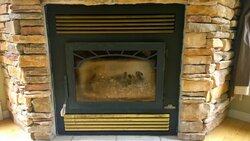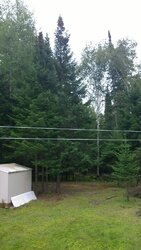Hey everyone, new here but I spent 3+ hours last night reading posts instead of sleeping. I'll see if I can condense my situation for hopefully some quick advice.
1. Bought current 13yr old 2500sqft 2 story home with finished basement 2 years ago in Northern Ontario, Canada. It's heated w/ 900l interior oil tank, radiant heat in the basement (running off oil water heater) & stand alone wood stove in the basement & insert on the main floor.
2. Previous owners said they spent $2600/year in 2012/2013 on oil but heated primarily with wood for the first 10 years. (Injury prevented further wood heating). Our first Year's bill was $4300 or so. 2nd year I was working from home so I kept both fireplaces running (filling every few hours) 24/7 and we still froze. There is no way that stand-alone stove heated the whole house.
3. I'm done freezing and I no longer work from home. My uncle bought a OWB (Heatmore 400 series) 10 years ago, said he was happy with the service of the local dealer. I didn't do the usual research I would do; met the Heatmor dealer and started planning for the install, quoted at $17k w/o labor. : /
4. Winter is coming. I have several cord of wood left over from last year that should be better seasoned this year. I have to purchase my wood; cut and split is $90/face cord. I have 3 acres of land so the odd downed tree will likely add to what I burn. Yesterday I cleared some trees to build a woodshed that I intended to face the OWB into (so I can load it from "inside"). Tomorrow I have a backhoe coming to dig the ~60' trench.
5. All was well until I started reading more about gasification and how the choice I've made is "old school". Heatmor's new X series is too new for me, not interested in a first gen furnace. That + being able to burn wood that may not be perfect, the lower maintenance costs, less time cleaning etc. were all reasons I chose the older waterjacket style. But is it the wrong choice?
Last night I got reading about gasification, choosing a brand that's known for them (no idea if they're available in Ontario yet), hooking up to external water tanks, and indoor wood boilers.... along with the thought of using an IWB, outdoors.
Suddenly, I'm lost & wondering if I should even be digging my trench tomorrow! Any input would be appreciated.
1. Bought current 13yr old 2500sqft 2 story home with finished basement 2 years ago in Northern Ontario, Canada. It's heated w/ 900l interior oil tank, radiant heat in the basement (running off oil water heater) & stand alone wood stove in the basement & insert on the main floor.
2. Previous owners said they spent $2600/year in 2012/2013 on oil but heated primarily with wood for the first 10 years. (Injury prevented further wood heating). Our first Year's bill was $4300 or so. 2nd year I was working from home so I kept both fireplaces running (filling every few hours) 24/7 and we still froze. There is no way that stand-alone stove heated the whole house.
3. I'm done freezing and I no longer work from home. My uncle bought a OWB (Heatmore 400 series) 10 years ago, said he was happy with the service of the local dealer. I didn't do the usual research I would do; met the Heatmor dealer and started planning for the install, quoted at $17k w/o labor. : /
4. Winter is coming. I have several cord of wood left over from last year that should be better seasoned this year. I have to purchase my wood; cut and split is $90/face cord. I have 3 acres of land so the odd downed tree will likely add to what I burn. Yesterday I cleared some trees to build a woodshed that I intended to face the OWB into (so I can load it from "inside"). Tomorrow I have a backhoe coming to dig the ~60' trench.
5. All was well until I started reading more about gasification and how the choice I've made is "old school". Heatmor's new X series is too new for me, not interested in a first gen furnace. That + being able to burn wood that may not be perfect, the lower maintenance costs, less time cleaning etc. were all reasons I chose the older waterjacket style. But is it the wrong choice?
Last night I got reading about gasification, choosing a brand that's known for them (no idea if they're available in Ontario yet), hooking up to external water tanks, and indoor wood boilers.... along with the thought of using an IWB, outdoors.
Suddenly, I'm lost & wondering if I should even be digging my trench tomorrow! Any input would be appreciated.
Last edited:


 What we would need to know is the price (or better the number of gallons/liter) used during the winter 2013/14 when the OP was solely heating with oil.
What we would need to know is the price (or better the number of gallons/liter) used during the winter 2013/14 when the OP was solely heating with oil. 
